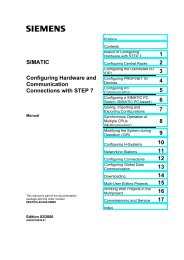II - DCE FEL ČVUT v Praze
II - DCE FEL ČVUT v Praze
II - DCE FEL ČVUT v Praze
Create successful ePaper yourself
Turn your PDF publications into a flip-book with our unique Google optimized e-Paper software.
Mechanical Configuration of an Automation System with SIMATIC S7 Ex Modules<br />
1.9.2 Distributed Arrangement of Systems with S7-300, M7-300 and<br />
ET 200M<br />
I/O Modules with Intrinsically-Safe Signals<br />
C79000-G7076-C152-04<br />
The process engineering of a plant, such as gas supply, requires a<br />
wide-ranging exchange of information between the systems with the<br />
distributed Ex I/O devices and the central, electrical or electronic<br />
measurement and control system. This necessitates a great number of cable<br />
connections, sometimes extending over several hundred meters - in the case<br />
of gas storage systems, over several thousands of meters. In the event of a<br />
lightning strike, therefore, extensive voltage pick-up occurs.<br />
A distributed arrangement of instrumentation and control equipment with<br />
relatively short cables to the plant, and the connection of distributed I/O<br />
stations to each other and to the central controller via a bus (PROFIBUS-DP)<br />
or fiber-optic cable, are an important measure for reducing overvoltages<br />
between sections of the plant.<br />
You will find more detailed information on this arrangement in the manuals<br />
specified in the foreword.<br />
1.9.3 Shielding of Cables and Buildings<br />
Overvoltages between separate plant sections or buildings cannot be avoided<br />
in practice by meshing. In the event of a lightning strike, a circulating current<br />
will flow over the path created by metal connections between the buildings<br />
or between a building and I/O device. Cable cores are ideal for this purpose.<br />
The lightning or partial lightning current must therefore be offered other<br />
conductive connections. Shielding which can be implemented in different<br />
ways is particularly suitable, for example:<br />
A helical current-rated metal strip or metal braid as the cable shield, e.g.<br />
NYCY or A2Y(K)Y.<br />
By installing the cables in continuously connected metal conduits which<br />
are grounded at both ends.<br />
By installing the cables in reinforced concrete ducts with throughconnected<br />
reinforcement or on closed cable racks made of metal.<br />
By laying conductors (shield conductors) in parallel with cables. This<br />
measure, however, only relieves the cables of partial lightning currents.<br />
or<br />
By laying fiber-optic cables.<br />
Overvoltage-sensitive equipment must also be shielded to ensure the currents<br />
at the cable ends cannot destroy this equipment. This is achieved with metal<br />
housings or by installing the equipment in metal cabinets which are<br />
connected to the ground conductor.<br />
1-35
















